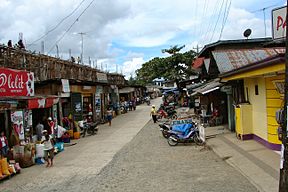Alicia, Bohol
Alicia | |
|---|---|
| Municipality of Alicia | |
 Municipality Hall | |
 Map of Bohol with Alicia highlighted | |
Location within the Philippines | |
| Coordinates: 9°53′45″N 124°26′29″E / 9.895708°N 124.441517°E | |
| Country | |
| Region | Central Visayas |
| Province | Bohol |
| District | 3rd District |
| Founded | 18 January 1950 |
| Barangays | 15 (see Barangays) |
| Government | |
| • Type | Sangguniang Bayan |
| • Mayor | Marnilou Ayuban |
| • Vice Mayor | Victoriano Torres |
| • Congressman | Arthur Yap |
| • Electorate | 17,111 voters (2022) |
| Area | |
| • Total | 114.50 km2 (44.21 sq mi) |
| Population (2020 census)[3] | |
| • Total | 24,374 |
| • Density | 210/km2 (550/sq mi) |
| Time zone | UTC+8 (PST) |
| ZIP code | 6314 |
| PSGC | |
| IDD : area code | +63 (0)38 |
| Income class | 4th municipal income class |
| Revenue (₱) | ₱ 114.7 million (2020) |
| Native languages | Boholano dialect Cebuano Tagalog |
| Patron saint | Joachim |
| Website | www |
Alicia, officially the Municipality of Alicia, (Cebuano: Lungsod sa Alicia; Tagalog: Bayan ng Alicia), is a 4th class municipality in the province of Bohol, Philippines. According to the 2020 census, it has a population of 24,374 people.[3]
Located 103 kilometres (64 mi) from Tagbilaran, it was formerly part of Mabini and was known as Batuanan (or Batuanon).[4][5]
Alicia celebrates its town fiesta on 26 July in honor of Saint Joachim.[6]
History
In the mid-19th century Alicia was one of the three largest and oldest towns of Bohol along with Catigbian and Balilihan. The town was where former followers of Dagohoy were given some land to till, but at the same time could be kept under the watchful eye of Spanish authorities.
In 1829, the year the Dagohoy Rebellion ended, the town was the largest of five such settlements, with over 6000 inhabitants.
In 1949, it became an independent municipality, which was renamed Alicia after Alicia Syquia, the wife of president Elpidio Quirino.[7] She and three of their children were massacred by the Japanese in 1945.
Barangays
Alicia comprises 15 barangays:
| PSGC | Barangay | Population | ±% p.a. | |||
|---|---|---|---|---|---|---|
| 2020[3] | 2010[8] | |||||
| 071202001 | Cabatang | 3.5% | 861 | 675 | 2.46% | |
| 071202002 | Cagongcagong | 1.8% | 440 | 423 | 0.39% | |
| 071202003 | Cambaol | 5.0% | 1,216 | 1,087 | 1.13% | |
| 071202004 | Cayacay | 7.8% | 1,897 | 1,713 | 1.03% | |
| 071202005 | Del Monte | 3.4% | 834 | 806 | 0.34% | |
| 071202006 | Katipunan | 9.5% | 2,317 | 2,230 | 0.38% | |
| 071202007 | La Hacienda | 15.4% | 3,758 | 3,710 | 0.13% | |
| 071202008 | Mahayag | 2.8% | 681 | 687 | −0.09% | |
| 071202009 | Napo | 5.3% | 1,295 | 1,255 | 0.31% | |
| 071202010 | Pagahat | 3.1% | 747 | 586 | 2.46% | |
| 071202011 | Poblacion (Calingganay) | 17.3% | 4,214 | 4,064 | 0.36% | |
| 071202012 | Progreso | 4.2% | 1,031 | 1,019 | 0.12% | |
| 071202013 | Putlongcam | 7.0% | 1,698 | 1,578 | 0.74% | |
| 071202014 | Sudlon (Omhon) | 2.7% | 656 | 648 | 0.12% | |
| 071202015 | Untaga | 7.7% | 1,872 | 1,804 | 0.37% | |
| Total | 24,374 | 22,285 | 0.90% | |||
Demographics
| Year | Pop. | ±% p.a. |
|---|---|---|
| 1960 | 11,860 | — |
| 1970 | 12,717 | +0.70% |
| 1975 | 14,770 | +3.05% |
| 1980 | 15,766 | +1.31% |
| 1990 | 18,653 | +1.70% |
| 1995 | 19,402 | +0.74% |
| 2000 | 21,605 | +2.33% |
| 2007 | 23,422 | +1.12% |
| 2010 | 22,285 | −1.79% |
| 2015 | 23,517 | +1.03% |
| Source: Philippine Statistics Authority[9][8][10][11] | ||
Mayors
-
- Pedro Huiso1950–1955
- Exequiel Madriñan
- Leoncio Garcia1956–1959
- Jesus Madriñan1960–1980
- Dominador Molina1980–1987
- Exequiel Madriñan Jr1988–1995
- Basilio Balahay1995–2001
- Bienvenido Molina2001–2007
- Pedro Miasco2007–2010
- Marnilou Ayuban2010–
Gallery
-
Poblacion and public market
-
Plaza and town hall
-
Residential street in Alicia
-
Church
References
- ^ Municipality of Alicia | (DILG)
- ^ "Province: Bohol". PSGC Interactive. Quezon City, Philippines: Philippine Statistics Authority. Retrieved 12 November 2016.
- ^ a b c Census of Population (2020). "Region VII (Central Visayas)". Total Population by Province, City, Municipality and Barangay. Philippine Statistics Authority. Retrieved 8 July 2021.
- ^ a b "Historical Sketch of the Municipality of Alicia". Municipality of Alicia. Retrieved 2012-09-07.
- ^ Tirol, Jes. Establishment of Batuanan town, its abolition and re-establishment as Alicia town Archived 2007-09-28 at the Wayback Machine
- ^ "Bohol Fiesta Schedule". "http://boholic.com". Retrieved February 12, 2019.
- ^ "History of Alicia". "www.bohol-philippines.com". Retrieved 2019-04-10.
- ^ a b Census of Population and Housing (2010). "Region VII (Central Visayas)" (PDF). Total Population by Province, City, Municipality and Barangay. National Statistics Office. Retrieved 29 June 2016.
- ^ Census of Population (2015). "Region VII (Central Visayas)". Total Population by Province, City, Municipality and Barangay. Philippine Statistics Authority. Retrieved 20 June 2016.
- ^ Censuses of Population (1903–2007). "Region VII (Central Visayas)". Table 1. Population Enumerated in Various Censuses by Province/Highly Urbanized City: 1903 to 2007. National Statistics Office.
- ^ "Province of Bohol". Municipality Population Data. Local Water Utilities Administration Research Division. Retrieved 17 December 2016.






